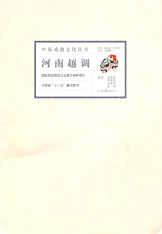河南越调
河南越调流行于河南及湖北北部地区,为河南三大剧种之一。
越调形成剧种以后,演出形式有三种:第一是皮影越调戏;第二是木偶越调戏;第三是越调大戏班。这三种演出形式,迄今仍然在湖北北部、安徽西部和河南的南阳一带农村流行。
河南越调音乐由于其历史悠久,既有较多的曲牌,又有较完整的板腔。唱腔主要为“越调”,有时也兼唱“吹腔”、“昆腔”、“七句半”等。伴奏乐器以四胡(俗名“上天梯”)为主,因而越调也有时被称“四股弦”,另以卧笛、月琴为辅,后来逐渐增加了短杆坠胡、闷子、二胡、唢呐、三弦和琵琶。
越调的传统剧目分为正装戏和外装戏两种,有四百多个。正装戏为越调的传统剧目,其结构严整、唱词深奥,每段唱词固定,并规定有一定的曲牌和调门,道白时用卧笛伴奏,主要演历史袍带戏,多以生、净为主角,如:《抱火斗》、《文王吃子》、《乌江岸》、《十五宫》等。外装戏多系活词连台本,也有许多公案戏。外装戏以小生、小丑为主角,词句通俗,多唱少白,生活气息浓厚,如《李双喜借粮》、《火焚绣楼》、《哭殿》等。
河南越调这个古老的戏曲剧种,能够长期在群众中流传,除了由于它拥有一批优秀的传统剧目和丰富多彩的唱腔音乐,还由于它在表演上表现丰富并别具特色。当代有代表性的演员有生行张秀卿、申凤梅,旦行毛爱莲等人。

主要责任者: 马紫晨,黄莉丽,王梦莹等
责任方式: 编著
出版者: 河南文艺出版社
出版地: 郑州
字数: 400 千字
页码: 1-375
开本: 16
中图分类号: J825.61
装帧: 简
语种:中
定价:38.00
出版时间:2010-01
丛书多卷书否:是
丛书名:中原戏曲文化丛书
丛书责任者:马紫晨
丛书责任方式:主编
书目简介:本册工具书是中原戏曲文化丛书之一,共收录329条词条。
被引频次:6